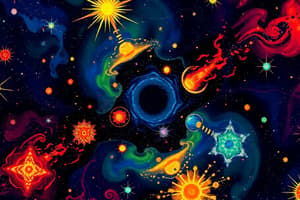Podcast
Questions and Answers
What primarily determines the path followed by a star during its life cycle?
What primarily determines the path followed by a star during its life cycle?
Its mass
Which of the following elements is primarily present in the early era of star formation? (Select all that apply)
Which of the following elements is primarily present in the early era of star formation? (Select all that apply)
- Helium (correct)
- Carbon
- Hydrogen (correct)
- Oxygen
A red giant star can maintain its status for around a billion years.
A red giant star can maintain its status for around a billion years.
True (A)
What is the process called when helium nuclei fuse into larger nuclei during the life of a star?
What is the process called when helium nuclei fuse into larger nuclei during the life of a star?
What happens to the core of a high mass star when it becomes primarily iron?
What happens to the core of a high mass star when it becomes primarily iron?
Who was Dmitri Ivanovich Mendeleev?
Who was Dmitri Ivanovich Mendeleev?
What is the significance of Moseley's law in the periodic table?
What is the significance of Moseley's law in the periodic table?
What element was the first artificially made element formed by bombarding Molybdenum with deuteron?
What element was the first artificially made element formed by bombarding Molybdenum with deuteron?
Superheavy elements have atomic numbers higher than 103.
Superheavy elements have atomic numbers higher than 103.
What was the primary aim of alchemy in historical contexts?
What was the primary aim of alchemy in historical contexts?
Flashcards are hidden until you start studying
Study Notes
Star Cycle
- Stars have a life cycle that spans millions to billions of years, influenced by their mass.
- The mass determines the amount of gas that collapses to form a star, which serves as fuel for fusion.
Low Mass or Average Star
- Mass ranges from a minimum of about thirteen Jupiter masses to masses similar to the Sun.
- Begins as a cloud of gas and dust, primarily composed of hydrogen and helium from the Big Bang.
- When nuclear fusion initiates, a yellow or red main sequence star forms, emitting energy from collisions within.
- The fusion process starts with proton fusion, creating deuterons, which subsequently fuse to form helium.
- A low mass star remains stable for billions of years, fusing hydrogen into helium while maintaining size and temperature.
- As hydrogen depletes, the core shrinks and heats, accelerating fusion and leading to outer layer expansion, transforming into a red giant star.
- The red giant phase lasts around a billion years until the core becomes predominantly helium, reaching the Helium Flash stage.
- In this phase, heavier elements like carbon and oxygen are produced through the triple alpha process.
- The star then transitions through the horizontal branch, expanding and becoming hotter until helium is exhausted.
- The core collapses, leading to the asymptotic giant branch, with the star swelling again until a final explosion ejects outer layers, leaving a white dwarf.
High Mass Star
- High mass stars are significantly more massive than the Sun and have a rapid and explosive demise.
- Formation begins with a large gas cloud, resulting in strong gravitational forces leading to higher core temperatures.
- High temperatures accelerate fusion rates, producing a larger, hotter, blue main sequence star.
- Unlike low mass stars, high mass stars exhaust their fuel within about a hundred million years.
- As hydrogen runs out, the core contracts, heats up, and expands into a giant star, capable of fusing heavier elements.
- These stars produce a sequence of fusion up to iron, the heaviest element that can be formed through fusion in stars.
- A high mass star ends its lifecycle with a supernova, a tremendous release of energy that also creates elements heavier than iron.
Synthesis of Elements
- Atomic spectra, akin to fingerprints, allow for the identification of elements present in samples.
- Isotopes have the same number of protons but different neutron counts.
- Dmitri Mendeleev formulated the Periodic Law and developed an early version of the periodic table based on atomic weight.
- Henry Moseley established the concept of atomic number, linking it to the number of protons through X-ray spectroscopy.
- X-ray spectroscopy is a technique for characterizing materials based on X-ray excitation.
Transuranic Elements
- Synthetic elements with atomic numbers higher than uranium (Z > 92) are classified as transuranic.
- Neptunium (Z = 93) was synthesized by E.M. MacMillan in 1940 using uranium and neutrons.
- Plutonium (Z = 94) was produced through nuclear reactions involving neptunium and other isotopes.
Superheavy Elements
- Elements with atomic numbers beyond 103 are defined as superheavy elements.
- Bohrium (Z = 107) was synthesized by bombarding bismuth with chromium.
Alchemy
- Alchemy is the ancient study aiming to transmute basic substances into others, often relating to magic and astrology.
- Practiced largely during the Middle Ages and Renaissance, it sought methods for transforming base metals into gold and discovering a universal solvent or elixir of life.
- Scholars and practitioners of this field are referred to as alchemists.
Studying That Suits You
Use AI to generate personalized quizzes and flashcards to suit your learning preferences.




